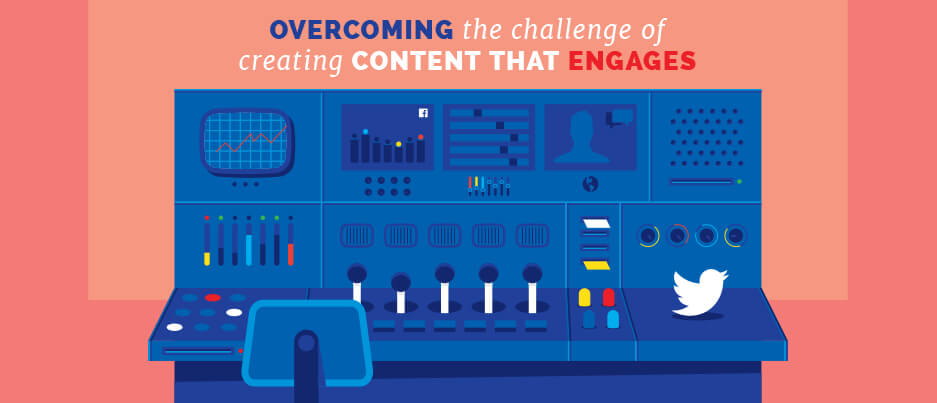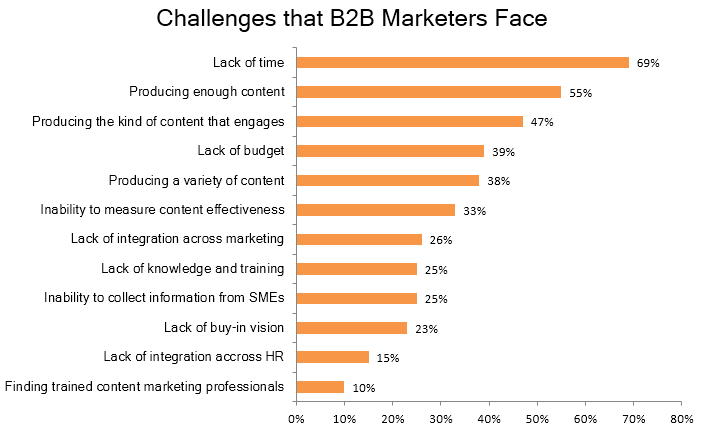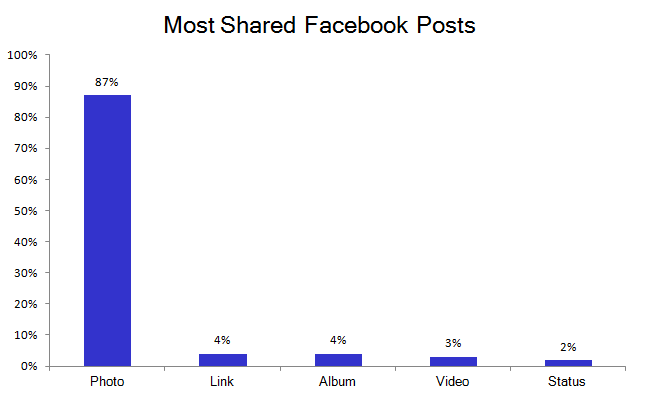Overcoming the Challenge of Creating Content that Engages

Cross-channel content optimization guide
White Paper by Four Dots
December, 2015
Download a full PDF version of this white paper here.
Introduction
The ability to produce relevant, quality content on a regular basis has always been a foundation of successful SEO and online marketing strategies. The constant flow of posts that deal with specific industry issues and, more importantly, aim to solve target consumers’ problems is a path to developing an organization’s online image that is known for authority, credibility and popularity among consumers. However, producing large amounts of content has long stopped being a path to engaging the audience; instead, what really matters is producing the exact type of content that appeals to the target readership.
This has become particularly important as the world of the web becomes a more competitive space and where it may be truly difficult to distinguish from all the other similar companies and offers out there. In fact, even if your offer is truly unique, it can hardly get in front of the right eyes if it is not made to be engaging. Namely, the pieces of content developed with the primary intention of offering something new and interesting to the audience stand more chances of being discussed and shared online.
Formulated in a way that transfers the target message easily, such an offer is likely to get sufficient attention, which is the ultimate goal of every content strategy.

Therefore, regardless of the channel you intend to use to distribute your content, you need to understand some basics of people’s behavior online. These should help you create posts that engage and inspire, which are the main characteristics of content that spreads. When it comes to content creation, however, there is a set of aspects that should be taken into consideration when planning a strategy that follows consumers’ demands and drives engagement. The first one is understanding peculiarities of specific channels in order to create content specifically for them.
Considering the challenges of content marketing, this white paper outlines the most important rules of creating engaging content, as well as some relevant stats every online marketer needs to know. With the ability to respond to consumers’ needs with the appropriate message timely and accurately, a company can significantly improve its visibility and relevancy online.
Challenges of content marketing
Content marketing is a field that has been rapidly growing over the last few years and that primarily focuses on engaging prospects across different online channels. Today, an increasing number of companies both large and small turn to content creation and distribution to expand their web presence and increase brand awareness.
However, while content strategy promises significant benefits, its successful implementation still faces different challenges in practice. A joint research by Content Marketing Institute and MarketingProfs found out that one of the most frequent challenges B2B marketers face is inability to produce the content that engages.
Namely, 16% of large companies (1000+ employees) and 8% of small companies (10 – 99 employees) say that this is the top challenge for their online marketing strategies.
Obviously, despite the size of budget allocated to content creation and distribution, companies still fail to see some critical benefits.

Source: http://www.iab.net
The fact that creating content that engages is at the top of the list of challenges points to the importance of understanding consumers’ needs and behavioral tendencies. Therefore, it is crucial for companies to find the right ways to gain insights into their target segment and understand its characteristics. As one of the activities that greatly improves the processes of identifying target consumers, as well as their requirements, data analysis is a critical step in developing the content that engages.
Content Strategy Planning
“Content quality is in the eye of the beholder. You have to understand the audience before you can “wow” it with great blog posts, whitepapers and webinars.”
Identifying target audience is a step that needs to be taken before online marketing strategy is implemented. This is particularly important in the hyper-connected age, when people are using multiple networks and platforms to find product or service information and engage with brands. Based on the existing customers’ data, marketers should develop buyer personas and determine the channels where they are most likely to search for brand information.
In terms of content strategy, this means that companies have to understand their audience before they determine which types of content will be created. A case study by MarketingSherpa revealed that content tailored for specific segments of the audience resulted in 124% increase in lead generation right after the product launch. To develop an efficient targeted persona strategy, they recommend the following steps:
- Step 1: Set basic audience segments (develop use-cases)
- Step 2: Research the segments (monitor search and behavioral data)
- Step 3: Dig deeper in each segment (recognize their needs)
- Step 4: Plan targeted content (optimize content for cross-channel distribution)
- Step 5: Establish a content review process (maintain quality and volume)
The Skytap example shown above is an interesting reference for all marketers, regardless of their business area. However, to create content that really engages, one needs to consider multiple other aspects of consumers’ behavior and identify the ones that would bring most benefits in terms of engagement.
Optimizing for cross-channel engagement
To ensure engagement across all the desired content distribution channels, marketers need to understand their specificities, as well as the types of engagement they could expect. The notion of engagement may differ depending on what a company wants to achieve and this is why it first needs to set the proper goals. Content optimization will afterwards follow the established goal and its performance would be easier to measure.
Engagement KPIs
“Engagement is any action a consumer takes with your content. It’s a like, view, comment or share. Social success should be based on the most valuable engagement, sharing and the earned reach that it generates around a key message.”
However, this may be far too simple to represent a base of an actual strategy. This is why engagements could be defined in relation to specific key performance indicators that the company finds most valuable. When it comes to KPIs, Christopher Ratcliff from Econsultancy gives a list of both online and offline KPIs that may be used to track engagements.
- • Dwell time (time on site)
- • Pages per visit
- • Bounce rate
- • Social shares
- • Comments and likes
- • Product reviews
- • Banner click-through rate
In addition to this, engagements may be:
- • Traffic from social media pages
- • Likes, comments or mentions on social media pages
- • Mentions from industry leaders
- • Enquires on a company’s website
Even with this list, defining the nature of engagement is not an easy task. However, these are some of the typical activities marketers consider important for fulfilling their ultimate goals. Therefore, any of these can serve as an appropriate engagement indicator that accounts for the efficiency of the strategy. In a precisely defined customer journey where all the goal completion points are in place, these KPIs represent a base for measuring success.
Types of content users engage with
In the age when users are overwhelmed with pieces of information presented online, companies need to establish themselves as credible sources of information. To do this, they need to understand 1) what types of information users seek from brands directly and 2) how they interact with the content that provides them. Therefore, engagements can be driven via multiple sources, all of which may be require different approaches.
Blog posts
When it comes to blog content, WP Engine Survey gives some insightful data about consumers’ engagement with brands online. One of their key findings is that consumers increasingly demand content directly delivered by companies themselves, most frequently via the official blogs. According to the survey, consumers think that company blogs are the space that:
- • Provides consumers with the most up to date information – 32%
- • Gives consumers a more personal connection with the company – 16%
- • Gives brands a voice – 15%
Obviously, informative content that describes a company or a product is probably the best way to attract prospects. Furthermore, companies can more easily determine the types of posts that drive more engagement by monitoring social media or website analytics for specific posts. Nevertheless, to be able to compare the efficiency of post types, company blogs should offer a range of different articles at regular intervals and collect previously established sets of data.
Social media
Social shares are typically the primary definition of engagement and a most frequent goal of content marketing. To understand what people share on social media, companies can use Facebook Insights to monitor their own posts or do a competitor analysis to see what they may be missing out. In 2012, Facebook did an internal study to determine which types of posts generate most engagement. Based on this, they recommend the following:

In addition to this, a recent research by SocialBakers found out that images are by far the most shared content on Facebook pages:
Similar to Facebook fans, Twitter followers also prefer to engage with photos. Considering the specificity of tweets, there are different ways to craft engaging tweets and some of the common indicators of what works best are presented on the graphic below.

Source: https://blog.twitter.com/media
Online ads
Personalization has long been the key driver of clicks on online ads. As reported in the Yahoo! 2014 survey of 6000 people, most consumers find personal ads more engaging (54%), educational (52%), time-saving (49%) and memorable (45%).
The study also shows that content personalization drives more engagement for entertainment and finance content, with overall 78% of consumers desiring a certain degree of content personalization. Therefore, the idea is to use data to design ads that primarily rely on personalized content to attract users’ attention and, subsequently, clicks. Moreover, around two thirds of consumers are fine with advertisers collecting their personal data on browsing behavior, previous purchases and profile, which only purports the idea that users are ready to make information available to online advertisers if this could improve their experience.
Therefore, when creating email ads it is important to first define the characteristics of the audience the ad will be delivered to. With most ad serving platforms this is possible by setting advanced targeting options, while some market knowledge should be gather by internal research. Afterwards, both the ad copy and any graphical addition should be adjusted to the identified preferences of a target consumer in order to encourage him or her to complete the action.
Email marketing
Email marketing is yet another aspect of content strategy that needs to be personalized in order to drive clicks to a defined landing page. To achieve this, marketers should optimize several aspects of their campaigns based on data they previously collected. Experian study found out that some of the most relevant factors of increased open rates are personalized email subjects (26% higher open rate), and responsive design (63% increase in click rates and 18% increase in transaction rates). In addition to this, they outline the most frequently tested elements of email marketing campaigns to determine which ones have most impact.

Source: http://www.experian.com/
While such tests give an insight into performance of email marketing campaigns, types of data collected play the greatest role in personalization. Therefore, besides the general information such as demographics and location, email marketers should also let their users decide on the types of email they want to receive (60% of marketers do not give this option).
“By capitalizing on data-driven email tactics and new trends in creative optimization, email marketers can delight and enchant their customers with optimal brand experiences that inspire more meaningful and profitable long-term relationships.”
When it comes to the very content that would be included in an email campaign, it should be conspicuously connected with a target reader’s needs. This means including clear and actionable message in the very subject, while the body of the email should contain only as much data as the reader needs to understand your message – basic graphic, a list of benefits/features and a clear call-to-action button.
Conclusions
In the age of aggressive content production and tight competition online, content creation acquires a whole new meaning. Instead of creating posts and ads that have a sole purpose of filling specific areas on a web page or simply increasing activity across social profiles, organizations need to find the ways to derive true value of their content development strategies. To be able to do so, they need to focus on a user, examine what it is that he or she expects from the company and start producing content that meets these expectations. Naturally, not all the organizations would be able to overcome this challenge so easily, but the data outlined above should help them set their focus. Afterwards, more specific and more detailed engagement strategy should come in place in order to ensure all the relevant online channels are properly handled.
References:
B2B Content Marketing 2014: Benchmarks, Budgets, and Trends – North America. CMI and MarketingProfs.
http://www.iab.net/media/file/B2BResearch2014.pdf
Measure What Matters Most. Think With Google.
https://storage.googleapis.com/think/docs/measure-what-matters-most_articles.pdf
WP Engine and TNS Survey.
http://www.businesswire.com/news/home/20140505006297/en/WP-Engine-Study-Majority-Americans-Original-Content#.VK7vf8kYFpm
How Brands Define Engagement. Digiday.
http://digiday.com/brands/how-brands-define-engagement/
What KPIs are you Using to Measure the Impact of Content Marketing. Econsultancy. https://econsultancy.com/blog/65180-what-kpis-are-you-using-to-measure-the-impact-of-content-marketing/
Photos Cluttering your Facebook Feed? Here’s Why. eMarketer.
http://www.emarketer.com/Article/Photos-Cluttering-Your-Facebook-Feed-Herersquos-Why/1010777/1
What Fuels Twitter Engagement. Twitter Media Blog.
https://blog.twitter.com/2014/what-fuels-a-tweets-engagement
Internet Marketing Research: Opportunities and Problems. Olivier Furrer and D. Sudharshan. http://www.unifr.ch/marketing/assets/files/2001_furrer_sudharshan_qualitative_market_research.pdf
What do Marketers Want from Big Data. Econsultancy.
http://www.emarketer.com/Article/What-Do-Marketers-Want-Big-Data/1009798
The Balancing Act: Getting Personalization Right. Yahoo.
https://advertising.yahoo.com/Insights/BALANCING-ACT.html
2013 Email Market Study. Experian.
http://www.experian.com/assets/marketing-services/white-papers/ccm-email-study-2013.pdf


 SEARCH
SEARCH


